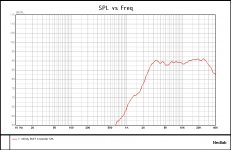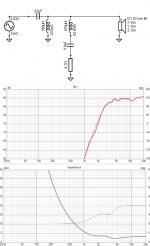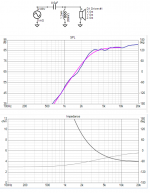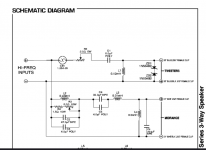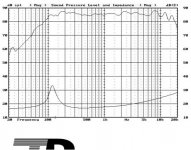Hello, I have been a big time lurker here for a few years, but finally thought I'd ask a question for something that's been bugging me for a long time. I understand the general difference between an acoustic and electrical slope and their phase ramifications. Furthermore, I found at least one post related to this but it didn't specifically answer my question. My question pertains more to the way talk about crossover slopes in forum posts, articles online, etc. I'll use an example...
In D'Appolito's article about the Thor system (THOR: A D’Appolito Transmission Line | audioXpress) he talks about the requisite crossover slopes, e.g. on page two he says, "For the THOR TL the goal was to design a fourth-order acoustic crossover response at a crossover frequency of 2500Hz." Is he talking here about an electrical fourth order crossover, or a lower order electrical crossover that achieves a fourth order roll off when summed with the natural roll off of the driver?
BTW, I've read e.g. LDC and a couple other books, but they don't clarify this for me. I now realize that I could have learned how to read the crossover diagrams in the article and answer this for myself... thank you for indulging a bit of my laziness.
P.S. Thank you to the community in general for so selflessly sharing. I'll pay it forward one day when I've achieved the requisite level of audio DIY fu.
In D'Appolito's article about the Thor system (THOR: A D’Appolito Transmission Line | audioXpress) he talks about the requisite crossover slopes, e.g. on page two he says, "For the THOR TL the goal was to design a fourth-order acoustic crossover response at a crossover frequency of 2500Hz." Is he talking here about an electrical fourth order crossover, or a lower order electrical crossover that achieves a fourth order roll off when summed with the natural roll off of the driver?
BTW, I've read e.g. LDC and a couple other books, but they don't clarify this for me. I now realize that I could have learned how to read the crossover diagrams in the article and answer this for myself... thank you for indulging a bit of my laziness.
P.S. Thank you to the community in general for so selflessly sharing. I'll pay it forward one day when I've achieved the requisite level of audio DIY fu.
Is he talking here about an electrical fourth order crossover, or a lower order electrical crossover that achieves a fourth order roll off when summed with the natural roll off of the driver?
The second case. From the standpoint of measured frequency response, the combined response of the driver and the electrical filter creates a summed overall response, and this response is the only one that actually matters.
Please take a look at this blog post I wrote specifically to help answer this question:
A Speaker Maker's Journey: Crossover Basics - Driver Response
A Speaker Maker's Journey: Crossover Basics - Driver Response
Thank you both so much for taking the time to read and answer my question. It was very helpful to un-wrinkle my thoughts on this. Have a wonderful day.
P.S. eriksquires, I did go and read your blog. Thanks!
P.S. eriksquires, I did go and read your blog. Thanks!
Hi.
I realize this thread is getting old(er), but I wish to ask for assistance with the following, please:
I have the following tweeter, which is about -3dB @ 2700Hz. I'd like to make a high-pass filter (electrical 2-pole or maybe 3 pole?) to work with the driver's natural roll-off to get a Fourth-Order acoustic high-pass response. The driver has a linear impedance of about 3.5 ohms, without any significant peak. I'm hoping to end up with a crossover point of around 3kHz or so.
I have seen this tweeter used with a single series 9.5uf cap, but want to use a fourth -order acoustic slope to mate with my midbass.
Thanks for any help.
-Charles
I realize this thread is getting old(er), but I wish to ask for assistance with the following, please:
I have the following tweeter, which is about -3dB @ 2700Hz. I'd like to make a high-pass filter (electrical 2-pole or maybe 3 pole?) to work with the driver's natural roll-off to get a Fourth-Order acoustic high-pass response. The driver has a linear impedance of about 3.5 ohms, without any significant peak. I'm hoping to end up with a crossover point of around 3kHz or so.
I have seen this tweeter used with a single series 9.5uf cap, but want to use a fourth -order acoustic slope to mate with my midbass.
Thanks for any help.
-Charles
Attachments
Your tweeter already has a steeper slope, which doesn't seem to leave much room.. However it is difficult to see, maybe you could show what's below 75dB.
Oh, sorry (needed room for impedance graph) I'll attach the full Monte
(BTW, I'm hoping to combine this with two 3" full-ranges used in an MTM configuration with mids approximately 6.5-7" center to center, hence the low x-over point). The tweeter appears to be a challenge to work that low, but the mfr. used it down to 3kHz in at least one application(although with ample protection in the form of back-to-back Zeners and a fuse).
Thanks for your kind reply and whatever assistance you can provide!
-Charles
(BTW, I'm hoping to combine this with two 3" full-ranges used in an MTM configuration with mids approximately 6.5-7" center to center, hence the low x-over point). The tweeter appears to be a challenge to work that low, but the mfr. used it down to 3kHz in at least one application(although with ample protection in the form of back-to-back Zeners and a fuse).
Thanks for your kind reply and whatever assistance you can provide!
-Charles
Attachments
No problem- see the lower trace in my first post.
It's an Infinity Kappa, model 908-3082N. I really like the quality of the highs with this tweeter (I tried it with a simple series cap and it seemed to complement my 3" drivers nicely, as their highs were a weak point)
It's an Infinity Kappa, model 908-3082N. I really like the quality of the highs with this tweeter (I tried it with a simple series cap and it seemed to complement my 3" drivers nicely, as their highs were a weak point)
Of course without knowing your required level this is just an exercise...3kHz or so.
Attachments
Looks promising for either case.
Might I ask :
1. What roll- off rate would these be considered?
2. Does the corresponding low-pass acoustic response need to be -3db or -6db at the crossover point (and does it need to be so steep)?
Thanks, guys
-Charles
Might I ask :
1. What roll- off rate would these be considered?
2. Does the corresponding low-pass acoustic response need to be -3db or -6db at the crossover point (and does it need to be so steep)?
Thanks, guys
-Charles
Both our offerings are fourth order, as you hoped for, so it's possible.
That's a common slope. More steep might reduce the tweeter signal slightly, maybe offer slightly more output.. however too far and you can run into other problems. Usually you want to begin around here when you're not sure.
That's a common slope. More steep might reduce the tweeter signal slightly, maybe offer slightly more output.. however too far and you can run into other problems. Usually you want to begin around here when you're not sure.
Usually somewhere between the two.2. Does the corresponding low-pass acoustic response need to be -3db or -6db at the crossover point
The falling-off slope band is where the driver is failing and without a very sharp XO slope (which is not achievable with the defunct passive type of XO), you may well be trafficking in the driver resonance. Bad thinking.
Stupid enough that we play woofers across their resonance, but there's no justification for playing other drivers except exclusively in their good band.
B.
Stupid enough that we play woofers across their resonance, but there's no justification for playing other drivers except exclusively in their good band.
B.
Of course without knowing your required level this is just an exercise...
In order to better match my mid-bsss level the required level for the tweeter is 90dB, crossing over @ 3kHz-3.2kHz.
Thanks,
- Charles,
Last edited:
The falling-off slope band is where the driver is failing and without a very sharp XO slope (which is not achievable with the defunct passive type of XO), you may well be trafficking in the driver resonance. Bad thinking.
Stupid enough that we play woofers across their resonance, but there's no justification for playing other drivers except exclusively in their good band.
B.
Infinity routinely used these drivers at 4kHz with only a two-pole filter (see pic).
I was hoping to get a bit more extension with a higher order filter.
Still hoping...
Attachments
I had hoped to use it between two Tang Band 3" mid-bass, in an MTM with approx 3.5" CTC spacing between mid and tweeter. The TB off-axis response falls above about 3kHz, and allowable MTM spacing also indicate close to 3k. I'm not ready to abandon this (yet). Again, I tried simple symmetrical 1-pole and they seemed to blend, but there was some lobing I heard.
Any ideas on a usable crossover point & slope?
Thanks
-Charles
Any ideas on a usable crossover point & slope?
Thanks
-Charles
Attachments
- Home
- Loudspeakers
- Multi-Way
- Acoustic vs. Electrical Crossover Slope

